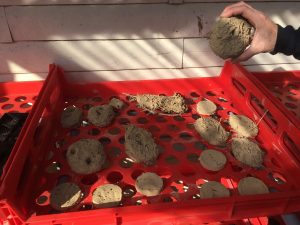On a Friday at Waikino School, you’ll see students in their house groups following their latest Enviroschools initiative – working together to create a healthy, peaceful school environment.
At any one time there might be several mini Action Learning Cycles underway, linked to or feeding off one another.
Lately, students have been actively grappling with issues and ideas around growing, cooking and sharing kai. They currently have a food garden but think they could improve it. At the start of 2018 the whole-school healthy eating focus culminated in student-organised harvest festival with food from the gardens prepared in 30 slow cookers. The slow cookers were useful but:
- What if the school had a child-friendly kitchen space near their kai garden?
- What if this space used ecological building principles?
- What could it look like?
- What would work best for Waikino School environment?
- How could students create a “sustainable building”?
Students started thinking about the possibilities and developing criteria for their kitchen. This included a space that workshops could be run: a place where people could meet, work together, share knowledge, skills and kai.
Many members of the school community contributed their ideas towards the design. A family recently returning from a visit to their homeland of Samoa shared photos and knowledge of fale.

Clay bricks made by students
Knowledge of shipping container conversion was shared with students. A local clay and permaculture expert helped with different design techniques.
“They come back to class talking more and taking bigger risks with learning … boys who wouldn’t write are writing. Girls who wouldn’t talk are talking. The students have such visionary ideas!” – Principal, Waikino School.
The students explored the school grounds and adjacent gully to see what useful resources they could find on-site for their project. A good clay deposit in the gully helped them with their decision to use adobe. They also gathered various fibres and returned to class to set up some trials using fair testing methods for their clay bricks.
Besides getting their hands gloriously dirty, the students were engaged in authentic, hands-on science and were loving every minute of it! As well as the action project for the sustainable outdoor kitchen, the over-all garden plans needed to be addressed. Their teacher formalised this into a challenge for the students. They were given a brief to design a 3 x 3 metre garden space. It had to have certain elements:
- re-used materials
- seating
- 1/3 of the space had to be used for growing
From the resulting plans, students chose key features that they would like to be included in the final design. These included poles and trellis for kiwifruit and grapes, a hügelkultur mountain making use of the rotten wood from the native area, a shell pathway, adobe pizza oven, a living archway and a herb/strawberry re-used tyre spiral.
When I asked a student about the project, she put it simply: “It’s so cool! We all have a say in what happens, it makes learning fun!”

The students worked in groups to create garden plans.